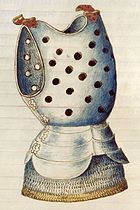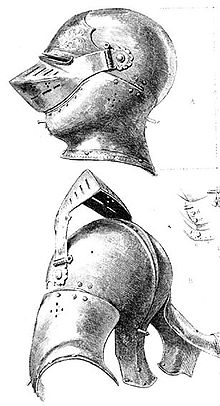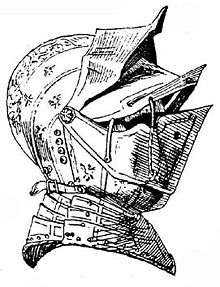- Close helm
-
In Medieval armor, the close helm was a military helmet worn by knights and other combatants in the late medieval and early renaissance era. It carried a visor that pivoted up and fully enclosed the head and neck area, unlike earlier helms such as the sallet and barbute, which sometimes may have left the wearer more exposed, or needed a bevor to be added to protect the chin and neck.
According to Oakeshot (Ewart Oakeshott "European Weapons and Armour. From Renaissance to the Industrial Revolution" ISBN 0-85115-789-0, page 121 in edition of 2000 by The Boydell Press, Woolbridge), the close helm is a helm which is very similar to an armet, but has a different method of opening. While an armet has two cheekpieces, a close helm instead has a kind of bevor, which is attached in the same way to pivots as its visor.
However, other authors do not make such difference between close helms and armets: e.g., Wendelin Boeheim in his "Handbuch der Waffenkunde. Das Waffenwesen in seiner historischen Entwicklung vom Beginn des Mittelalters bis zum Ende des 18 Jahrhunders" (Leipzig 1890) does not separate close helms and armets. However, he does separate "Burgundian" Armet as kind of an armet (or a close helm) which has a specific vertigous joint for being attached to a special gorget made from movable rings.
The close helmet most probably evolved from a number of different helmets, from the armet, the Italian bellows-visored sallets and possibly hinged great bascinets. As a type of helm, they largely appeared in the later 15th century, though there are earlier examples.
The close helm was used in battle, but was also popular in tournaments, where sometimes the visor would be less solid, and instead have bars which would still offer protection but allow more visibility. Close helms for jousting were heavier, weighing up to 12 pounds, while the helms for normal combat were lighter, often around 8 pounds.
As said above, the close helm is very similar to the armet. The main difference is that the bevor/visor of an armet is split in the middle, with the two halves hinged at the cheek, opening outwards to expose the face of the wearer. The bevor of a 'true' close helm opens by swinging upwards; it is in one piece and shares the pivot point with the visor. The close helm often had a catch to hold the visor down.
Both forms of helm may have had a round plate at the back of the helm, a protective rondel. The purpose of this is not truly known, but it is suspected that it protected strapping.
References
- Edge, David. Arms and Armour of the Medieval Knight. London: Bison Books, 1988, pp. 105–106.
- Wallace Collection Catalogue. European arms and Armour Vol. 1: Armour. 1962. pp. 142, 152.
External
- http://www.eskimo.com/~cwn/close.html Patterns for the Close helm
Head Armet · Barbute · Bascinet · Burgonet · Cervelliere · Close helm · Close helmet · Great helm · Frog mouth(helm) · Hounskull · Lobster tail pot · Mail coif · Morion · Nasal helmet · Sallet · Spangenhelm · Kettle hat
Visor · Falling buffe · Nossel
Neck Torso Brigandine · Cuirass · Culet · Plackart · Fauld · Hauberk · Codpiece · Lance rest · Loin-guard · Jack of plateArms Legs Component pieces Categories:- Medieval helmets
- Helmets
Wikimedia Foundation. 2010.


